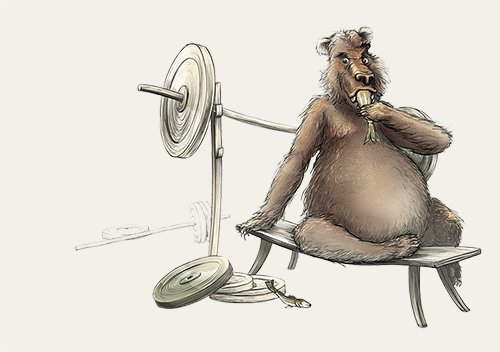Why Bears Don’t Bench-Press
Animal Exercise
The next time you consider skipping a workout, remember that exercise isn’t for the birds . . . or bears.
Every New Year, the onslaught begins again. Ads for gyms, aerobic exercise fads, and workout gear flood social media, billboards, and commercials. Everywhere you look are reminders of your resolution to get in shape and eat healthy. And if you put in the work, you see results. After all, God designed our bodies to respond to exercise by increasing our lung capacity and the strength of our muscles.
But have you ever noticed that you don’t see animals working out to get fit? Birds aren’t out there lifting rocks to get their wings ready for a winter flight. Bears don’t bench-press to prepare for spring foraging. Gazelles don’t run practice sprints to get the hoof up on cheetahs. They just have the power and speed they need when they need it.
While that news may be a bit discouraging to those of us training for a 5K run, the beauty of this power-at-the-ready feature is an incredible design that points to an incredible Designer.

Fit on the Fly
When it comes to migration champions, few creatures can outdo bar-headed geese. A 2011 study found that these high-flying fowl reach an altitude of at least 21,000 feet (6,400 meters) as they migrate over the tallest mountains in the world to reach South Asia. Because the hemoglobin (a protein) is better at binding oxygen in their blood, the geese can soar through the air with lower levels of oxygen than other birds need. That means they can keep on honking in the heights.
Scientists captured some of the birds in their Mongolian breeding grounds and outfitted them with GPS monitors and devices that recorded heart rate and body temperature. (Think of it like a small smartwatch that allowed the scientists to keep tabs on the birds before, during, and after their epic journeys.) And while the migration story in itself is amazing, what captivated some scientists even more was how the geese prepared for their record-setting flight.
They didn’t. At all.
Before their arduous adventure through the air, the bar-headed geese changed nothing about their routine. They swam, ate, and still grew stronger and fitter for flight. In fact, the same thing happens with many other types of birds that migrate long distances. God equipped these able-bodied avians with the ability to gain flight muscle mass and stronger hearts right when they need it. Their bodies just know when it’s time to get ready.
Skipping the gym to stay fit isn’t just for the birds. Many species of bears, for example, often pack on weight before hibernating, and when they wake up, they have lost very little muscle mass. As soon as they shake off the sleep, they’re ready to run, forage, and chow down.
Even your house cat shows how lazing around in the sunshine doesn’t diminish its dexterity completely—especially when a neighborhood dog gives chase.
Wild Workouts
So do animals exercise at all? Well, sort of. Young animals often “exercise” by playing with siblings to get ready for life on their own, and most animals stay fit thanks to their daily activities such as flying, walking, or hunting. Animals kept in captivity often have lower fitness levels than their wild relatives. For example, captive barnacle geese have been found to have lower mass in their cardiac ventricles, the two lower heart chambers that push blood to the lungs and the rest of the body.
This isn’t to say animals wouldn’t exercise if given the chance. In one fascinating study, scientists put hamster wheels in the forest and mounted cameras to watch. As you might expect, mice jumped on, but the cameras also caught frogs and even snails and slugs taking the wheels for a spin. (And you thought your gym could be a zoo!)
But the results are mixed as to whether regular, intentional exercise is even good for animals. According to some studies, mosquitofish living in a fast-flowing stream exhibit better fitness than fish living in a stagnant pool of water. In another study, zebra finches were trained over time to earn their food by flapping their wings harder and harder to stay aloft. But the tiny birds actually showed increased cellular damage with no benefit to their fitness. Perhaps it’s safest to say that God equipped animals to stay healthy and fit while they simply survive day to day in a world gone wild (Genesis 3).
Made to Move
But humans? Now that’s a different story. Consistent exercise definitely does our bodies good.
Even Adam had a job to do—care for the animals and a garden (Genesis 1:28–29, 2:15). While there were no weeds before the fall (Genesis 3:18), Adam and Eve still had their fair share of muscle-building work to do—with healthier bodies not yet impacted by the curse.
In a way, you could say getting active is a way for us to get back to Genesis.
After Adam sinned, the work only got harder and sweatier (Genesis 3:19)—at least until modern conveniences made regular physical labor less necessary and couch surfing much easier. And like those animals in captivity, our bodies show the impact when we aren’t active. In a way, you could say getting active is a way for us to get back to Genesis.
Even evolutionists would agree we humans were “built to move,” which makes us completely unique from the great apes. (You know, the ones they claim we’re related to.) After all, apes don’t need to do deadlifts to burn off their dinner. They have healthy hearts without any need to sweat out a workout. But while evolutionary scientists would say this difference comes from our ancestors’ sudden penchant to walk upright and sprint across the savannah, the Bible paints a much different picture. That is, we were created in God’s image—separate from the apes—and made to move by our Creator.
So while exercise isn’t for the birds—they stay fit doing what they normally do—it is for human bodies designed to move from the very beginning.
Answers Magazine
January–March 2021
Meet the team of artists and writers behind the world’s most pro-life museum exhibit.
Browse Issue SubscribeRecommended Resources

Answers in Genesis is an apologetics ministry, dedicated to helping Christians defend their faith and proclaim the good news of Jesus Christ.
- Customer Service 800.778.3390
- © 2024 Answers in Genesis





